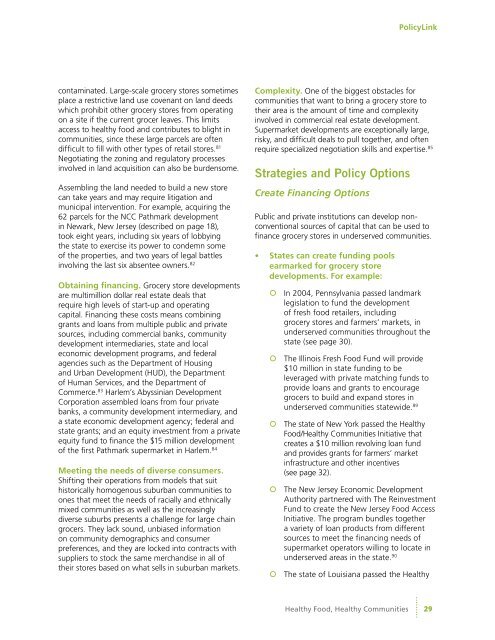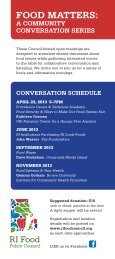Promising Strategies to Improve Access to Fresh, Healthy Food and ...
Promising Strategies to Improve Access to Fresh, Healthy Food and ...
Promising Strategies to Improve Access to Fresh, Healthy Food and ...
You also want an ePaper? Increase the reach of your titles
YUMPU automatically turns print PDFs into web optimized ePapers that Google loves.
PolicyLinkcontaminated. Large-scale grocery s<strong>to</strong>res sometimesplace a restrictive l<strong>and</strong> use covenant on l<strong>and</strong> deedswhich prohibit other grocery s<strong>to</strong>res from operatingon a site if the current grocer leaves. This limitsaccess <strong>to</strong> healthy food <strong>and</strong> contributes <strong>to</strong> blight incommunities, since these large parcels are oftendifficult <strong>to</strong> fill with other types of retail s<strong>to</strong>res. 81Negotiating the zoning <strong>and</strong> regula<strong>to</strong>ry processesinvolved in l<strong>and</strong> acquisition can also be burdensome.Assembling the l<strong>and</strong> needed <strong>to</strong> build a new s<strong>to</strong>recan take years <strong>and</strong> may require litigation <strong>and</strong>municipal intervention. For example, acquiring the62 parcels for the NCC Pathmark developmentin Newark, New Jersey (described on page 18),<strong>to</strong>ok eight years, including six years of lobbyingthe state <strong>to</strong> exercise its power <strong>to</strong> condemn someof the properties, <strong>and</strong> two years of legal battlesinvolving the last six absentee owners. 82Obtaining financing. Grocery s<strong>to</strong>re developmentsare multimillion dollar real estate deals thatrequire high levels of start-up <strong>and</strong> operatingcapital. Financing these costs means combininggrants <strong>and</strong> loans from multiple public <strong>and</strong> privatesources, including commercial banks, communitydevelopment intermediaries, state <strong>and</strong> localeconomic development programs, <strong>and</strong> federalagencies such as the Department of Housing<strong>and</strong> Urban Development (HUD), the Departmen<strong>to</strong>f Human Services, <strong>and</strong> the Department ofCommerce. 83 Harlem’s Abyssinian DevelopmentCorporation assembled loans from four privatebanks, a community development intermediary, <strong>and</strong>a state economic development agency; federal <strong>and</strong>state grants; <strong>and</strong> an equity investment from a privateequity fund <strong>to</strong> finance the $15 million developmen<strong>to</strong>f the first Pathmark supermarket in Harlem. 84Meeting the needs of diverse consumers.Shifting their operations from models that suithis<strong>to</strong>rically homogenous suburban communities <strong>to</strong>ones that meet the needs of racially <strong>and</strong> ethnicallymixed communities as well as the increasinglydiverse suburbs presents a challenge for large chaingrocers. They lack sound, unbiased informationon community demographics <strong>and</strong> consumerpreferences, <strong>and</strong> they are locked in<strong>to</strong> contracts withsuppliers <strong>to</strong> s<strong>to</strong>ck the same merch<strong>and</strong>ise in all oftheir s<strong>to</strong>res based on what sells in suburban markets.Complexity. One of the biggest obstacles forcommunities that want <strong>to</strong> bring a grocery s<strong>to</strong>re <strong>to</strong>their area is the amount of time <strong>and</strong> complexityinvolved in commercial real estate development.Supermarket developments are exceptionally large,risky, <strong>and</strong> difficult deals <strong>to</strong> pull <strong>to</strong>gether, <strong>and</strong> oftenrequire specialized negotiation skills <strong>and</strong> expertise. 85<strong>Strategies</strong> <strong>and</strong> Policy OptionsCreate Financing OptionsPublic <strong>and</strong> private institutions can develop nonconventionalsources of capital that can be used <strong>to</strong>finance grocery s<strong>to</strong>res in underserved communities.• States can create funding poolsearmarked for grocery s<strong>to</strong>redevelopments. For example:| | In 2004, Pennsylvania passed l<strong>and</strong>marklegislation <strong>to</strong> fund the developmen<strong>to</strong>f fresh food retailers, includinggrocery s<strong>to</strong>res <strong>and</strong> farmers’ markets, inunderserved communities throughout thestate (see page 30).| | The Illinois <strong>Fresh</strong> <strong>Food</strong> Fund will provide$10 million in state funding <strong>to</strong> beleveraged with private matching funds <strong>to</strong>provide loans <strong>and</strong> grants <strong>to</strong> encouragegrocers <strong>to</strong> build <strong>and</strong> exp<strong>and</strong> s<strong>to</strong>res inunderserved communities statewide. 89| | The state of New York passed the <strong>Healthy</strong><strong>Food</strong>/<strong>Healthy</strong> Communities Initiative thatcreates a $10 million revolving loan fund<strong>and</strong> provides grants for farmers’ marketinfrastructure <strong>and</strong> other incentives(see page 32).| | The New Jersey Economic DevelopmentAuthority partnered with The ReinvestmentFund <strong>to</strong> create the New Jersey <strong>Food</strong> <strong>Access</strong>Initiative. The program bundles <strong>to</strong>gethera variety of loan products from differentsources <strong>to</strong> meet the financing needs ofsupermarket opera<strong>to</strong>rs willing <strong>to</strong> locate inunderserved areas in the state. 90| | The state of Louisiana passed the <strong>Healthy</strong><strong>Healthy</strong> <strong>Food</strong>, <strong>Healthy</strong> Communities29



